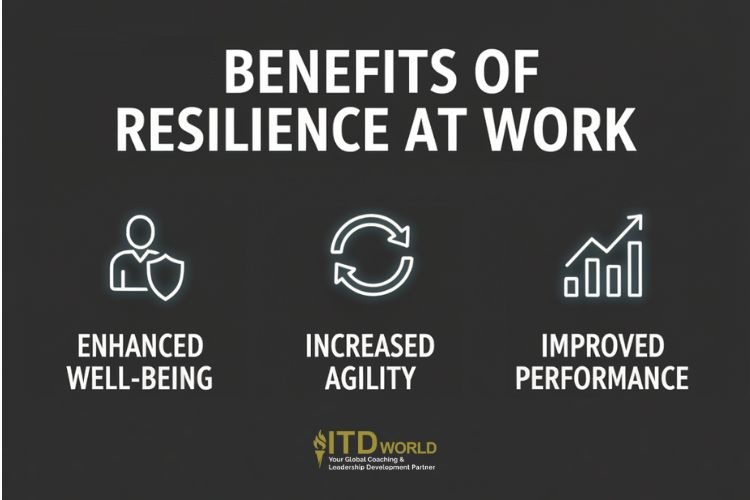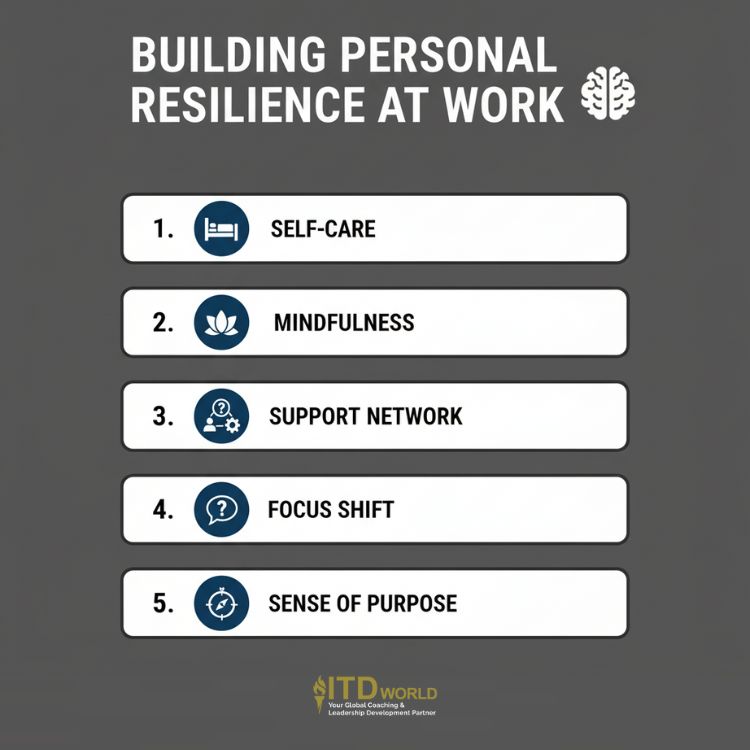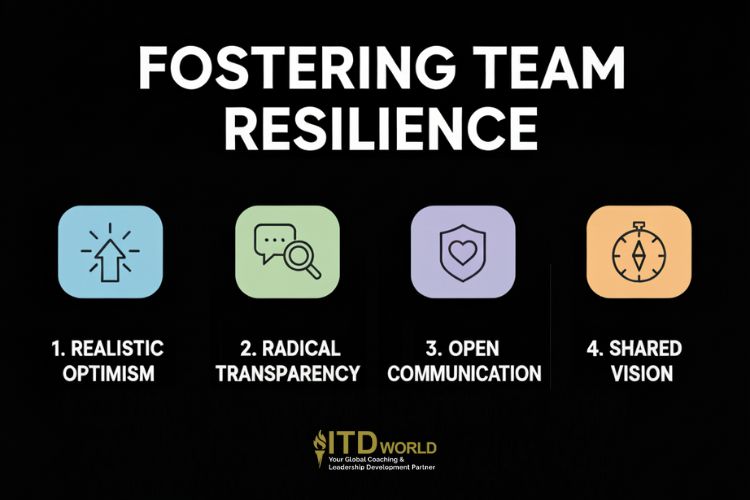Resilience in the workplace is essential for individuals and organizations to navigate today’s constant disruption.
Gone are the days when disruption was an occasional jolt to the system. Today’s business landscape is defined by it, a perpetual state of “permacrisis” where economic shifts, technological leaps, and unending change are the standard. Amidst this relentless environment, the paramount skill for individuals and organizations isn’t simply strength, but resilience. Cultivating resilience in the workplace is now essential – so that one may absorb shocks, gracefully adapt to turbulence, and decisively chart a course forward, even when the future seems obscured.
|
Author: Jonathan M. Pham |
Highlights
- Workplace resilience is the ability of individuals, teams, and organizations to not only withstand and adapt to adversity, disruption, and chronic stress, but also to grow and become more effective as a result of these challenges. It has become a crucial requirement in today’s constantly disrupted business environment, as it directly enhances employee well-being and retention, increases organizational agility and innovation, and ultimately improves overall performance and productivity.
- Essentially, workplace resilience is a result of internal strengths like cognitive flexibility, emotional regulation, self-efficacy, and a strong sense of purpose – all supported by external factors such as supportive relationships and a positive, learning-oriented organizational culture.
- Building personal resilience at work involves prioritizing self-care, practicing mindfulness and self-reflection, cultivating a strong support network, focusing on controllable aspects, and connecting with a sense of purpose.
- As a leader, fostering team resilience involves modeling calm and realistic optimism, communicating with radical transparency, promoting psychological safety, and anchoring the team in a shared vision; while organizations support this by investing in well-being programs, promoting healthy and flexible work practices, and making resilience a core leadership competency.
- Common obstacles to building resilience at work include the misconception that it means “toughing it out,” “resilience fatigue” from constant pressure, and the ineffectiveness of a one-size-fits-all approach to support.
- Workplace resilience, though seemingly intangible, can be measured through direct psychometric assessments and indirectly via business metrics like employee engagement, retention, absenteeism, and sustained performance during adversity.
What is Resilience in the Workplace?
Workplace resilience is the capacity of individuals, teams, and organizations to withstand, adapt to, and grow from adversity, disruption, and chronic stress. Far beyond mere endurance, it involves a dynamic capability that can be learned, developed, and embedded into the fabric of a company over time.
As you may see from the definition above, one of the concept’s most critical parts is the idea of growth. In other words, resilience is not just about “toughing it out” or returning to the original state after a challenge. It is about bouncing forward or failing upward – i.e. using the experience of adversity as a catalyst for learning, strengthening capabilities, and becoming more effective than before. It transforms challenges from threats to be endured into opportunities to be leveraged.

Example: Consider a sales team whose top-selling product is suddenly made obsolete by a competitor’s innovation. A typical team is likely to feel demoralized, see themselves as victims of the market, and passively wait for a new product to sell. However, with resilience, they would actively reframe the situation. The leader would facilitate a discussion asking, “What can we learn from our competitor’s success? What does this tell us about what the market wants now? How can we use our deep customer relationships to gather intelligence and help shape our company’s next innovation?”
Why is Resilience Important in the Workplace?
In the past, resilience might have been considered a personal virtue. And yet today, it has become a core business strategy. In an environment of constant disruption from AI advancements, economic volatility, and organizational restructuring, the ability to withstand pressure and adapt to change is no longer optional. It is a critical capability that directly impacts performance, talent retention, and long-term survival.
The need is pressing. Gallup’s “State of the Global Workplace” reports consistently show that employee stress remains at a record high worldwide. This epidemic of burnout is not just a human crisis; it is a business crisis that leads to lower productivity, higher absenteeism, and increased turnover. Fortunately, promoting workplace resilience is the strategic antidote to the problem above.
Benefits of resilience at work:
- Enhanced employee well-being and retention
Resilient individuals are better equipped to manage stress and avoid burnout; this translates to a healthier, more sustainable workforce. In fact, research from organizations like SHRM has revealed a strong correlation between personal resilience and a higher level of job satisfaction and engagement.
- Increased agility and innovation
Resilient teams are not afraid of change or failure; they see them as learning opportunities. Their willingness to adapt allows them to feel comfortable making experiments and trying new ideas, thereby providing a solid foundation for businesses to weather “storms” and navigate uncertainty.
- Improved performance and productivity
There is a direct link between well-being and performance. Research has demonstrated that individuals with higher levels of resilience and well-being are more engaged, focused, and ultimately more productive, which results in a direct positive impact on the organization’s bottom line.

The importance of resilience in the workplace
Organizational Resilience in Practice: The Johnson & Johnson Case
The ultimate test of organizational resilience is how a company responds during an unforeseen crisis. The 1982 Tylenol crisis involving Johnson & Johnson is a masterclass in this. When cyanide-laced Tylenol capsules led to several deaths, it created a massive public health scare and an existential threat to the Tylenol brand, which represented a significant portion of the company’s profits.
- The resilient response: Guided by their long-standing corporate “Credo” that put public safety first, J&J’s leadership took immediate action. They prioritized people over profits by issuing a nationwide recall of all Tylenol products – a move that cost them an estimated $100 million. They communicated transparently with the public and re-launched the product months later in new, triple-sealed, tamper-resistant packaging.
- The outcome: Because they acted with integrity and took decisive, responsible action, Johnson & Johnson did not just save the Tylenol brand; they emerged from the crisis with an enhanced reputation for trustworthiness that has endured for decades.
Components of Resilience in the Workplace: A Psychological Toolkit
Resilience is not a mysterious, singular quality that some people have and others do not. In fact, modern psychology shows that it is a dynamic process built from a set of specific, learnable skills and mindsets, which are then either supported or undermined by a person’s environment.
The inner strengths: Your psychological core
Personal resilience starts from within. These are the mindsets and emotional competencies that allow one to process and respond to adversity constructively, rather than being overwhelmed by it.
- Cognitive flexibility and optimism: The ability to reframe a negative event, challenge unhelpful thought patterns, and find the learning opportunity within a setback. It is coupled with a sense of realistic optimism – a belief that you can influence the future in a positive way.
Example: Instead of seeing a failed project as a disaster, a person with cognitive flexibility would frame it as, “This approach didn’t produce the result we wanted, but it gave us invaluable data that will make our next attempt successful.”
- Emotional regulation: The skill of managing your own emotional responses to stress. It is not about suppressing emotion, but about acknowledging it without letting it take over your decision-making – so that you may remain calm, clear-headed, and deliberate when under pressure.
- Self-efficacy: A person’s core belief in their own ability to handle challenges, learn new things, and succeed. It is a form of quiet self-confidence that fuels persistence and encourages proactive problem-solving.
- A strong sense of purpose: The connection to a meaningful “why” that is larger than the immediate task. When people feel their work is contributing to a purpose they believe in, they are likely to find it easier to endure difficult periods because their effort feels significant.
The external supports: Your resilience ecosystem
Individual resilience is greatly amplified or diminished by the environment and relationships surrounding a person. A supportive ecosystem provides a powerful buffer against stress and burnout.
- Supportive relationships: Having a network of trusted colleagues, peers, and leaders creates a crucial sense of psychological safety. This allows individuals to be vulnerable, ask for help when they are struggling, and share challenges without fear of judgment, which is essential for preventing isolation.
- A positive and learning-oriented culture: An organization’s culture plays a huge role here. For instance, a company that makes “blameless post-mortems” a standard practice after a difficult project is building a resilient culture. The focus is on learning and improving the system, which empowers team members to take smart risks in the future.
Resilience, therefore, is a powerful combination of what’s inside you – your mindsets and skills – and what’s around you – your relationships and your culture.
Building Personal Resilience in the Workplace
Organizational resilience begins with the strength and well-being of each person. The following are proactive, personal disciplines that any individual can practice to enhance their own capacity to navigate stress and thrive through adversity.
-
Prioritize foundational self-care
It is nearly impossible to be mentally strong when you are physically depleted. As such, you should treat adequate sleep, proper nutrition, and regular physical activity not as luxuries to be enjoyed when you have time – but as essential components of your professional performance. This also includes taking short, regular breaks throughout the workday to decompress and prevent the cumulative buildup of stress.
-
Practice mindfulness & self-reflection
This is the practice of observing your thoughts and emotions without being controlled by them. It is the core skill for developing the “emotional regulation” pillar of resilience.
In practice: Consider simple, accessible activities like meditation, journaling, or deep-breathing exercises. Just five minutes each day should be enough to significantly improve your ability to stay calm and focused under pressure, allowing you to respond to challenges thoughtfully rather than reacting impulsively.
Read more: Thoughtful Leadership – Why It Matters in Today’s Hectic World
-
Cultivate a strong support network
Resilient people do not face challenges in isolation. They intentionally invest in a network of supportive relationships with trusted colleagues, coaches/ mentors, friends, and family – which offer different perspectives, provide crucial emotional support, and serve as a vital reminder that one is not alone in their struggles.
-
Focus on what you can control
In times of great uncertainty, it is easy to become overwhelmed by external factors beyond your influence. A key resilience skill is shifting the focus back to your own attitude and actions.
Gratitude provides a powerful solution to this. At the end of a difficult day, taking just one minute to identify three things that went well or that you are thankful for can significantly turn your inner state from a sense of powerlessness to one of agency and realistic optimism.
-
Connect with a sense of purpose or spirituality
For many, the deepest source of resilience is a connection to a sense of purpose and values that are larger than oneself. In a professional context, this is not necessarily about religion. Rather, it can be about connecting to your core values, contributing to a cause you believe in, or finding meaning in serving others.
As exemplified by leaders like the late Dr. Kazuo Inamori, whose philosophy guided him to make decisions based on what was “right as a human being” (敬天愛人 – “Respect the Divine and Love People“), connecting your daily actions to a stable set of personal values provides a powerful source of strength and meaning during turbulent times.
Read more: Spiritual Leadership – A Remedy for Today’s Workplace Woes

How to Foster Team Resilience as a Leader
While personal resilience is the foundation, a leader acts as a “multiplier” – one with a unique ability to influence their team’s collective capacity to navigate challenges. Their daily behaviors create an environment that can either amplify stress or cultivate the psychological fortitude needed to thrive through adversity.

-
Model calm and realistic optimism
A team takes its emotional cues directly from its leader. In a crisis, the leader acts as the “emotional thermostat” for the group. Their composure is a critical asset that can prevent widespread panic and anxiety.
In practice: This does not mean pretending problems don’t exist. Rather, it is about acknowledging the difficulty with a calm and confident demeanor. For instance: “This is a significant challenge, and it won’t be easy. But I have absolute confidence in this team’s ability to work together and figure it out.”
-
Communicate with radical transparency
In a vacuum of information, people will fill the void with fear and rumors. Relentless and transparent communication is a leader’s primary tool for fighting uncertainty. Even if there is no new information to share, make an effort to hold regular, short check-in meetings – and be honest about what you know, what you don’t, and what you are doing to find out more. Doing so prevents the rumor mill from creating unnecessary anxiety.
-
Promote psychological safety
A resilient team is one where members feel safe to be vulnerable – to admit mistakes, voice concerns, or suggest a risky idea without fear of blame or ridicule. A leader fosters such an environment by how they respond to bad news. When a team member brings a problem to them, their first response should always be, “Thank you for bringing this to my attention early.” This rewards transparency and encourages proactive problem-solving, rather than creating a culture where problems are hidden until they become unmanageable crises.
-
Anchor the team in a shared vision
During times of chaos, when daily tasks and priorities might be shifting, a strong sense of shared vision becomes a powerful, stabilizing anchor. It provides the “why” that motivates a team to persevere through difficult “hows.”
Example: A resilient leader constantly reminds the team of their mission. At the start of a difficult week, they might say, “I know things are turbulent right now, but let’s remember our core purpose: to make our customers’ lives easier. Let’s focus everything we do this week on that single goal.”
How to foster resilience in the workplace
Creating a Resilient System: A Guide for Organizations
-
Invest in well-being programs
Organizations should provide their people with tangible resources to support their mental, emotional, and physical health, especially during times of high stress. More than basic health insurance, they need to offer robust Employee Assistance Programs (EAP) that offer confidential counseling and support services. Additionally, it is recommended that companies allow access to mindfulness and stress-management apps – as well as run practical workshops on topics like financial wellness or preventing burnout.
-
Promote healthy and flexible work practices
An organization’s policies and unspoken cultural norms around work are a primary driver of either resilience or burnout. A resilient organization intentionally designs its work practices to be sustainable for its people – by implementing flexible work policies (e.g. hybrid schedules, adaptable hours) that allow employees to better manage the demands of their personal and professional lives.
Critically, it also means that senior leaders must actively discourage a culture of overwork. A policy of “no-meeting Fridays” or leaders who visibly take their full vacation time sends a powerful message that rest and recovery are valued and essential for long-term high performance.
-
Make resilience a core leadership competency
The most effective way to ensure resilience is embedded across the organization is to formally build it into your leadership DNA. This means teaching the skills of resilience, not just hoping that leaders possess them.
In practice: Make resilience and its related qualities – such as emotional regulation and leading through change – a key part of your leadership competency model. Provide formal training and coaching to equip your executives with the tools to manage their own inner state. When resilience is treated as a core leadership capability, on par with strategic thinking or financial acumen, it signals to the entire organization that this is an essential requirement for success.
Read more: High-performance Culture – A Blueprint for Driving Excellence

Adaptability and resilience in the workplace
Challenges of Building Resilience at Work
- Mistaking resilience for “Toughing it out”
This is probably the most dangerous misconception surrounding the topic. “Resilience” can be misused by some companies as an expectation for employees to silently endure excessive workloads, poor management, or a toxic environment. This framing unfairly places the entire burden of adapting on the individual, rather than on the organization to fix underlying problems.
Solution: Promote the practice of speaking up. True organizational resilience is not about individual endurance; it is about collective problem-solving. This requires a culture of high psychological safety where everyone feels safe to raise their concerns or discuss issues without fear of reprisal.
A healthy culture isn’t one where people never complain; it’s one where they feel empowered to say, “This process is broken, and it’s causing burnout on our team,” with confidence that leadership will listen and take action.
- “Resilience fatigue” & constant pressure
In a “permacrisis” environment, the constant demand to “brace oneself” and “bounce back” can itself become exhausting. Employees may feel like they are never allowed to have a difficult day or feel tired, leading to a new form of burnout known as “resilience fatigue.”
Solution: Model and encourage rest and recovery. Resilience is not about having an infinite supply of energy; it is about managing your energy effectively. This requires cycles of effort and renewal.
In practice: Leaders must actively model this balance. They can say, “The team has just finished an incredibly intense project. I want everyone to take the next two days to decompress and focus only on essential tasks. We need to recharge before we tackle the next challenge.”
- The “one-size-fits-all” approach to support
Organizations or leaders often make the mistake of assuming that everyone has the same level of innate resilience – or that the same type of support will work for every individual.
Solution: Practice personalized and empathetic leadership. The key is to recognize that people respond to stress in different ways and therefore require different forms of support. As such, leaders need to get to know their team members as individuals. They need to understand that one person might need clear, direct instructions during a crisis to feel secure, while another might require more autonomy and space to problem-solve. Instead of applying a single strategy, they tailor their support by asking each of them, “What do you specifically need from me right now to be successful?”
Read more: Emotional Intelligence in Leadership – How to Lead with Heart
Measuring Resilience in the Workplace
While resilience may feel like an intangible quality, its presence – or absence – has a tangible impact that can be tracked through a combination of direct assessments and indirect business metrics.
- Direct assessment
One way to measure resilience is to use scientifically validated psychometric assessments designed for this purpose. These tools are designed to gauge the underlying psychological components of resilience, such as optimism, cognitive flexibility, and self-efficacy, which we discussed earlier.
How it works: By administering an assessment like the Workplace Resilience Inventory (WRI) or other similar validated scales, an organization can create a baseline understanding of the current resilience levels across different teams and departments. This data then serves as a basis for pinpointing specific areas of vulnerability – and for targeting development efforts where they are needed most.
It is crucial that these tools are used for developmental purposes, not for performance evaluation, to maintain employee trust.
- Indirect business metrics
The impact of a resilient workforce can also be clearly seen in a variety of standard business and HR metrics.
-
- Employee engagement and morale: Track your regular employee engagement survey scores. A steady or increasing score, especially during a period of organizational change or market disruption, is a strong indicator of a resilient culture.
- Retention and turnover rates: A key metric is your voluntary turnover rate. If your turnover remains stable or decreases during a tough industry downturn while competitors are seeing a talent exodus, it’s a reliable sign of your organization’s superior resilience.
- Absenteeism and sick leave data: Higher resilience is typically correlated with better employee well-being and fewer stress-related illnesses. Monitoring trends in absenteeism rates over time can provide an indirect measure of your workforce’s capacity to cope with pressure.
- Performance through adversity: Analyze your team’s ability to maintain productivity and quality standards against their KPIs during a challenging quarter. This provides a clear, bottom-line measure of how well your team can withstand disruption.

Resilience in the workforce
Resilience in the Workplace Quotes
Check out more quotes about resilience here!
Resilience is accepting your new reality, even if it’s less good than the one you had before.
Elizabeth Edwards
Flexibility is the key to stability.
John Wooden
The only thing you have control over is your attitude.
Viktor Frankl
It’s your reaction to adversity, not adversity itself, that determines how your life’s story will develop.
Dieter F. Uchtdorf
I have not failed. I’ve just found 10,000 ways that won’t work.
Thomas A. Edison
The pessimist complains about the wind; the optimist expects it to change; the realist adjusts the sails.
William Arthur Ward
The true test of leadership is how well you function in a crisis.
The gem cannot be polished without friction, nor man perfected without trials.
Chinese Proverb
The bamboo that bends is stronger than the oak that resists.
Fall seven times, stand up eight.
Japanese Proverb
Books on Resilience in the Workplace
- The Resilience Plan by Marie-Hélène Pelletier: A practical guide that emphasizes resilience as a skill – not a trait – plus actionable strategies for cultivating it in high-pressure environments.
- Good Team, Bad Team by Sarah Thurber & Blair Miller: Explores how team dynamics affect resilience and performance, as well as tools to transform dysfunctional teams into thriving ones.
- Smaller Is Better by Brady Brim-DeForest: Focuses on agile team structures and how smaller, focused groups can foster resilience and innovation.
- Best Team Ever by David Burkus: A glimpse into what makes resilient teams tick, backed by research and real-world examples.
- Multipliers by Liz Wiseman: While not solely about resilience, Wiseman’s work demonstrates how leaders can amplify the capabilities of their teams, fostering a positive culture.
- Managing for Resilience by Monique Crane: A guide for leaders to support employee wellbeing and performance through organizational strategies.
- Resilient by Rick Hanson & Forrest Hanson: Explores 12 inner strengths – including gratitude and calm – that allow individuals to thrive in stressful work environments.
- Anxiety at Work by Adrian Gostick & Chester Elton: Tackles workplace anxiety and 8 strategies to build team resilience and handle uncertainty.
- The Resilient Employee by Rosalind Cardinal: A practical manual for employees to cope with change and thrive amid workplace challenges.
- Rise Together by Dr. Sam Mather: Presents neuroscience-backed strategies to foster resilient, engaged teams through psychological safety and connection.
Resilience in the Workplace Training
Building a resilient organization is one of the most proactive and strategic investments a business can make in its long-term success. As we’ve explored, this requires a holistic approach that cultivates the capabilities of individuals, leaders, and the organization as a whole. While the principles are clear, the most effective way to do it at scale is through targeted, expert-led training and development programs.
High-impact resilience training moves beyond theory and focuses on imparting practical, applicable competencies. For individuals, these includes techniques for managing stress, practicing mindfulness, and developing cognitive flexibility. For leaders, these involve the skills of leading through change, creating psychological safety, and coaching their teams.
At ITD World, we specialize in helping organizations build the human-centric qualities needed to thrive in a turbulent world. Our training solutions are designed to cultivate the resilience required for modern business challenges.
- Leadership resilience and agility workshops: Our interactive workshops provide leaders and their teams with the practical tools and mental frameworks to manage stress, adapt to change, and maintain high performance under pressure.
- Executive coaching: We offer confidential, one-on-one coaching for senior leaders to hone their personal resilience, enabling them to lead with calm and clarity and to guide their teams through periods of uncertainty.
- Customized in-house solutions: We partner with you to design and deliver bespoke programs that contribute to the establishment of a comprehensive, enterprise-wide culture of resilience. These solutions are tailored to your specific industry, challenges, and strategic goals.
Ready to build a more resilient, agile, and thriving organization? Contact ITD World today to learn how our solutions can equip you and your team to face any challenge!
Other resources you might be interested in:
- Future Ready Organization: 11 Tips to Building One
- Ego in the Workplace: The Hidden ‘Evil’ Behind Team Dysfunctions
- Continuous Feedback: A Cornerstone of Modern Workplace

